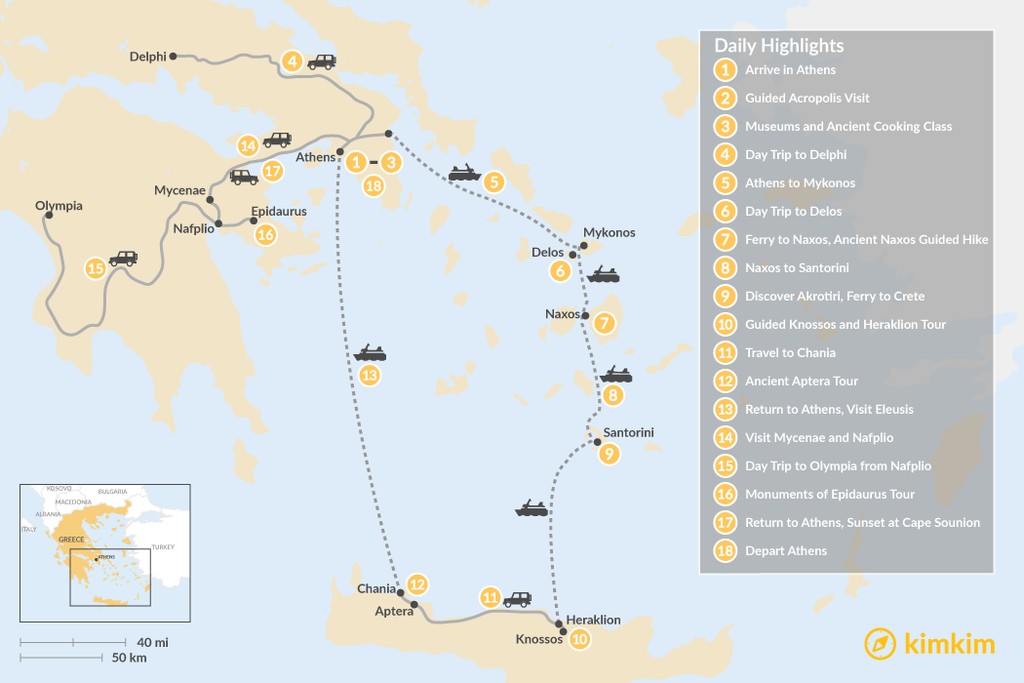Highlights
- Consult the oracle at the sacred site of Delphi
- Learn to cook like the ancient Greeks
- Explore the birthplace of Apollo and Artemis with a day trip to Delos
- Go hiking on the ancient island of Naxos
- Walk the Minotaur's labyrinth at Knossos
Brief Itinerary
| Day | Highlights | Overnight |
|---|---|---|
| Day 1 | Arrive in Athens | Athens |
| Day 2 | Guided Acropolis Visit | Athens |
| Day 3 | Museums and Ancient Cooking Class | Athens |
| Day 4 | Day Trip to Delphi | Athens |
| Day 5 | Athens to Mykonos | Mykonos |
| Day 6 | Day Trip to Delos | Mykonos |
| Day 7 | Ferry to Naxos and Ancient Naxos Guided Hike | Naxos |
| Day 8 | Naxos to Santorini | Santorini |
| Day 9 | Discover Prehistoric Akrotiri, Ferry to Crete | Heraklion |
| Day 10 | Guided Knossos and Heraklion Tour | Heraklion |
| Day 11 | Travel to Chania | Chania |
| Day 12 | Ancient Aptera Tour | Chania |
| Day 13 | Return to Athens, Visit Archaeological Site of Eleusis | Athens |
| Day 14 | Visit Mycenae and Nafplio | Nafplio |
| Day 15 | Day Trip to Olympia from Nafplio | Nafplio |
| Day 16 | Monuments of Epidaurus Tour | Nafplio |
| Day 17 | Return to Athens, Sunset at Cape Sounion | Athens |
| Day 18 | Depart Athens |
Detailed Itinerary
Day 1: Arrive in Athens
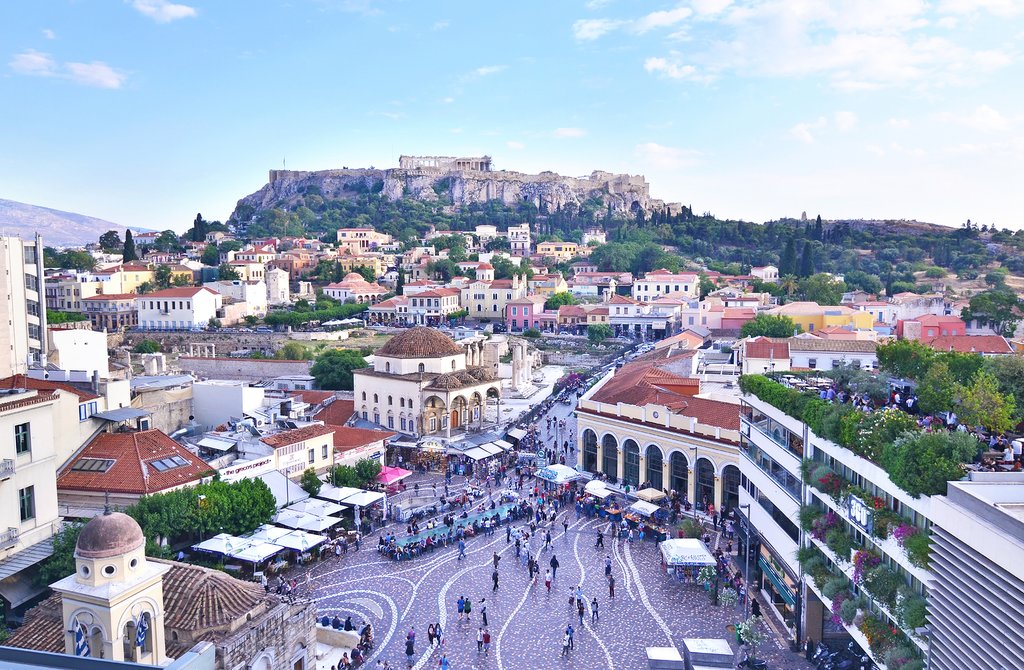
Welcome to Greece! You'll begin your trip in Athens, home to both the iconic Acropolis and so much more. The mythology of this spectacular city precedes it, with towering temples to Classical deities and the ruins of ancient marketplaces rubbing shoulders with lively nightlife, crowded flea markets, and contemporary cuisine. Make the most of your time in the city at some of these spots:
- Check out the views of the can't-miss Parthenon. (Pro tip: The Parthenon is the temple, the Acropolis is the hill.) This temple to Athena has enchanted visitors since its construction was completed in 438 BC. It's probably the first thing that comes to your mind when you think of ancient Greece and is visible from many of the city's high points.
- Stop at the sprawling National Museum for a crash course in ancient iconography. Be sure to seek out the room housing the Antikythera mechanism, essentially an ancient astronomical computer.
- Visit a smaller archaeological site at the Tower of the Winds, then stroll down neighboring pedestrian Aiolou Street to stop at shops and cafes.
- Find your perfect souvenir or sun hat in the busy stalls of the Monastiraki flea market.
Spend your evening exploring the up-and-coming Pangrati neighborhood or amid the nightlife and mezze of the Psyrri district.
Day 2: Guided Acropolis Visit

Today you'll get to experience the mighty Acropolis—ruins of the iconic 5th-century BCE complex located on the rocky hilltop overlooking the city. Take a guided tour of the entire settlement with an English-speaking professional guide who will share the stories of the country's most famous monument. In addition to the iconic Parthenon, dedicated to the city's patron goddess Athena, you'll view and learn about the Propylaea, the Temple of Athena Nike, and the most sacred temple of Erechtheion, all located on the sacred rock of the Acropolis.
Complement your tour with a trip to the nearby modern Acropolis Museum. Many of the more delicate statues and other artifacts originally found at the Acropolis have been moved here, but you can imagine them in their previous home as you explore the exhibits. Complete your visit with a stop in its cafe for either lunch or a relaxed snack and coffee.
Stop to explore the Anafiotika neighborhood on the northeast side of the hill before you leave. The oldest neighborhood in the city, Anafiotika's classic white geometric architecture echoes the motifs of the Cyclades in this tranquil urban oasis.
Day 3: Museums and Ancient Cooking Class

Start your morning at one of Athens' more off-beat museums. Some of your options include:
- Museum of Cycladic Art, where you can also buy some truly unique souvenirs
- The digital interactive museum at the Platonic Academy, next to the site where the actual Academy stood
- Museum of Ancient Greek Technology in the center of Athens, featuring a working model of the Antikythera mechanism, which can roughly be described as the first analog computer. It was used to predict astronomical positions and eclipses years in advance.
Have a light lunch, but don't get too into the cafes as your afternoon class will teach you to cook and eat like an ancient Athenian. A resident chef will take you on a journey of discovery into the methods used by the Ancient Greeks to cook their meals. You'll use ingredients available today to reproduce the distinct flavors found in classical dishes over the course of this 3-hour class. And no class is complete without the opportunity to sample the fruits of your labor over dinner (with wine included, of course).
Day 4: Day Trip to Delphi

Today, you'll seek out the oracle during a day trip to the ruins of Delphi, once home to priestesses of Apollo who Ancient Greeks believed could predict the future. After being transferred from your hotel to Delphi (about 2.5 hours from the city), you'll take a guided tour through this sprawling archaeological site, with stops such as the Treasury of the Athenians, the Temple of Apollo, and expansive theater.
Explore the ruins or venture up an ancient footpath once used by worshippers of the god Pan, who started from the temples of Delphi and proceeded to Corycean Grotto for their religious rites, surrounded by the valley of olive trees and views of the Corinthian Gulf and peaks of the Peloponnese on your way.
Outside of the ruins, you'll head to an old town district that used to serve as the leather tanner's district. One of Greece's last bellmakers keeps his workshop here; if you're lucky, he may be on site for a visit. Lunch will be served under the plane trees in the town square, with cheeses, Amfissa olives, and traditional home cooking.
Head indoors after lunch to the museum, a short downhill walk away. Wander through its halls to find the bronze Charioteer of Delphi, marble Sphinx of Naxos, and what may be the first recorded notation of a melody once inscribed on the walls of the Athenian Treasury.
You'll be transferred back to Athens in the late afternoon to rest up or spend the evening out and about in the city.
Day 5: Athens to Mykonos

You'll start your time in the islands on Mykonos, one of the most famous islands in the Cyclades chain. Known for its glitzy restaurants and nightlife, art scene, and jet set crowds (it was recently home to a Gucci pop-up boutique), Mykonos will throw you headfirst into your island adventure.
Your first day's itinerary is up to you. You'll receive a personalized list of tips for exploration, but some highlights include:
- If you need to get your toes in the sand immediately, head to remote Agios Sostis beach to find your own isolated paradise.
- For a more active experience, Ftelia Beach is known for its excellent windsurfing.
- Stroll through Little Venice, an 18th-century neighborhood where colorful former captains' mansions and seaside restaurants seem to sprout straight from the sea. It's also right next to the island's famous hillside windmills for great photo ops.
Day 6: Day Trip to Delos

Travel back in time after breakfast with a morning boat ride out to the archaeological site at Delos. You'll board a small boat at the old port to cruise for 45 minutes out to one of ancient Greece's most sacred sites. This small island was the center of the Cyclades during the Classical era and the mythological birthplace of twin deities Apollo and Artemis. Pilgrims from around the region were attracted to the mystical site and helped it evolve into one of the largest trade centers of the Mediterranean.
Your guided tour will wind you through the foundations of former traders' mansions, temples, and landmarks such as the Terrace of the Lions. Don't skip the island museum, where many of the smaller artifacts and frescoes have been moved to protect them from the elements.
You'll return to Mykonos in time to catch up on your shopping in your the afternoon as you explore some of the best boutiques in the Aegean, or check out the weathered Faros Armenistis lighthouse perched high above the Aegean on the island's northwestern tip, with views across to the neighboring island of Tinos.
Chat with a local specialist who can help organize your trip.
Day 7: Ferry to Naxos and Ancient Naxos Guided Hike

After breakfast, it’s time to ferry over to bustling Naxos. The island has an active main town where you can shop and admire the Venetian architecture, a historic Kastro (castle) area, and expansive beaches. It also boasts lovely hiking trails that wind around ancient sites and quaint villages.
Once you're settled, you'll head to the village of Myli, where you'll pick up an old footpath with your guide that leads to the island's ancient aqueduct. Hike up to the nearby quarry, where you'll find two large kouros, unfinished statues of ancient Greek gods, lying on the ground. Originally intended to hold up a temple roof, these giant statues were abandoned by their ancient sculptors when they discovered faults in the marble, but they're no less impressive for that today.
Pass the statues along with olive groves, orchards, and a shady riverside. You'll visit the Catholic church of Theoskepasti, also known as Agios Mamas, the island's oldest chapel, along with Episkopi, the summer residence of the Catholic archbishop, on this 2.5-hour guided hike.
Stop in Mesi Potamia on your way back to town to take a break at a taverna under the trees on the river bank. Spend your afternoon exploring the little town along with its neighboring riverside settlements at Ano Potamia and Kato Potamia, connected by a walking path, or return to the main town for a well-deserved beach break.
For dinner, wander up the hill through the streets of the Kastro neighborhood to pick out your favorite of the area's tavernas, where you can sample the island's fresh produce in its best forms.
Day 8: Naxos to Santorini

After breakfast at your hotel, you'll get an early ferry to Santorini. Nothing says "good morning" like watching the sun coming up over the island's iconic cubic architecture. Upon arrival, you'll take in the island's central caldera—the site of one of the largest volcanic eruptions in history—rising above you.
The island's volcanic history has led to the formation of some of the more unique beaches in the Greek islands, along with the dramatic cliff views on the island's caldera side. Spend your day relaxing at the beach or catching some exercise—and even more views—from one of Santorini’s more than 12 scenic walking routes, ranging from between two to eight miles each. At dinner, sample the island's signature cherry tomatoes and white eggplants as guest stars in seafood dishes or the main event.
Day 9: Discover Prehistoric Akrotiri, Ferry to Crete
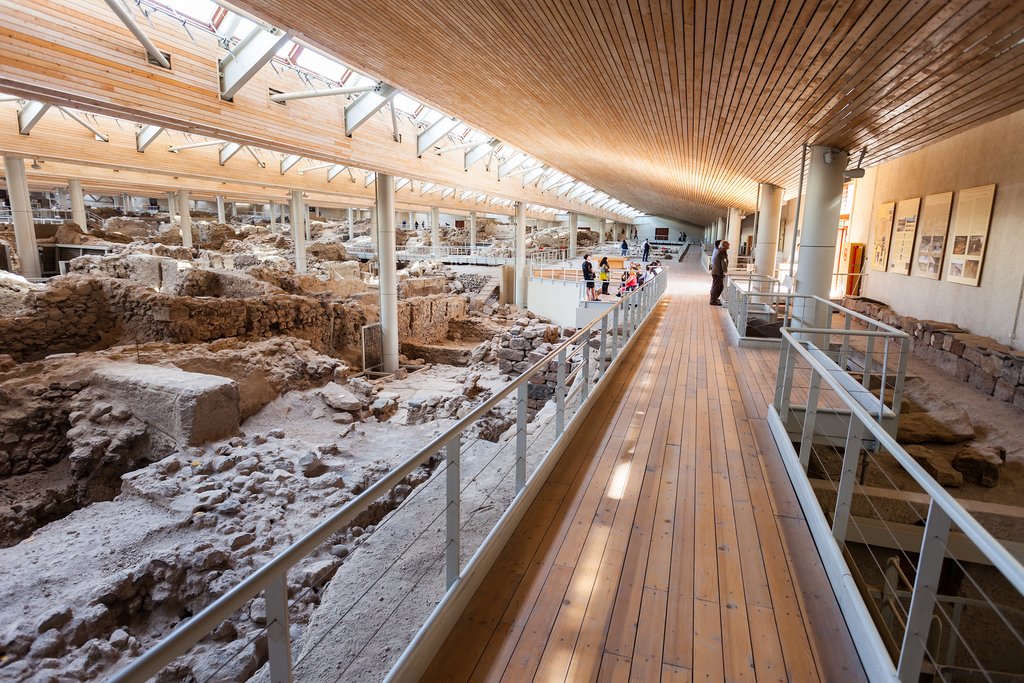
Take a guided tour of one of the Aegean's most significant prehistoric settlements. You'll head to the excavated city at Akrotiri, hidden away at the southern tip of Santorini on the slopes of the caldera. These ruins were once the site of one of the Bronze Age’s most advanced settlements, which prospered for centuries before being buried by a volcanic eruption in the mid-second millennium BC. You'll have the morning to explore its well-preserved (thanks to the volcanic eruption) streets alongside a local guide who will share its stories.
The Museum of Prehistoric Thera Museum and Archaeological Museum of Thera complement your visit, with findings including murals preserved from Akrotiri and the settlement of ancient Thera once found on the eastern part of the island. On your way back, stop to see the three bells of Fira. The trio of bells atop this blue-domed church is pictured on many of the postcards you'll find on the island, and now it's your turn to take a photo of your own.
Once you've wrapped up, you'll catch a ferry over to Crete, the largest and most populous of the 230 inhabited Greek islands.
Day 10: Guided Knossos and Heraklion Tour

Set off for a guided exploration of the magnificent Palace of Knossos. This 3,500-year-old Minoan palace is a sprawling maze of royal chambers, grand staircases, storerooms, and workshops. The evocative Bronze Age site is believed to be Europe's oldest city; it flourished for nearly 2,000 years as an economic center, trading with cities across the Mediterranean.
Follow it up with a guided stroll through the streets of Heraklion, exploring the old city's medieval streets with architecture representing the island's Venetian past. Highlights include the elegant arches of the Loggia, now in use as the town hall, and the Koules Venetian fortress along the harbor walls. In the afternoon, don't miss the Archaeological Museum, home to one of the largest collections of Minoan artifacts in the world.
Spend the evening strolling with the locals through the old town of Heraklion. A pleasant pedestrian street connects the port area with the Lions' Square and its Venetian fountain. Don't miss "mama's food" at Anchorage Traditional Mezedopolio nearby.
Day 11: Travel to Chania
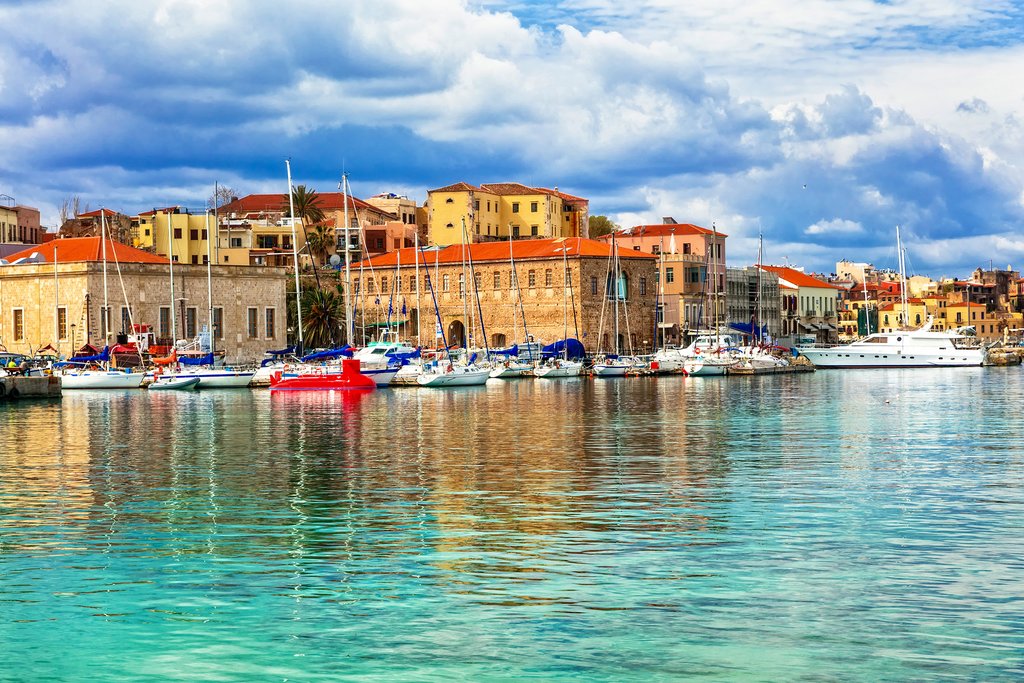
Today, you'll continue onward to Chania, a city (and region) on the northwest coast of Crete. Chania itself is the second largest city in Crete and one of the most scenic spots on an island with stiff competition for that title. Life in this former Venetian city revolves around its charming 14th-century harbor, narrow streets with winding alleys, and colorful architecture influenced by past Ottoman and Egyptian eras.
While you're exploring the area, don't miss some of these spots:
- The elevated neighborhoods of Topanas, Splantzia, Kolombo, and Kasteli for panoramic harbor views, Cretan taverns, and architectural history. You can see the ruins of the Minoan city of Kydonia and high walls of former Venetian moats integrated into the city.
- The Municipal Market of Chania and neighboring Municipal Garden to enjoy a coffee amid the shade of the trees or garden clocktower.
- The Botanical Parks and Gardens of Crete to enjoy Cretan nature at its finest. The special micro-climate formed at this specific area allows plants from three different climate zones to grow in the park.
- The olive-oil-producing region of Vouves, to the west of the city, complete with a museum and one of the oldest olive trees in existence.
- Falassarna and Elafonissi beaches, also to the west, where you can find solitude on the sands.
Top it all off with a sunset drink on the rooftop at trendy Pallas or visit Cafe Koukouvaya for a pastry and a view of Chania town and harbor.
Day 12: Ancient Aptera Tour

Travel back in time after breakfast with a guided trip to the archaeological site at ancient Aptera. The ruins of this once-powerful city are filled with traces of the past, from the times when archers used to inhabit the city for centuries before it was destroyed by an earthquake. Find out more from your guide or just indulge in the extraordinary views towards the Souda Gulf.
Your free afternoon and evening back in Chania will leave you plenty of time for souvenir shopping and exploration. Sample some of the area's Turkish influence with mezzes at Tamam, a taverna located inside a former Turkish bath in the old quarter, or opt for a creative modern twist on Cretan cuisine at Portes.
Day 13: Return to Athens, Visit Archaeological Site of Eleusis

Return to Athens this morning to continue your explorations on the mainland.
Your main activity for today is a visit to archaeological site at Eleusis located just outside of the city of Athens, via the Hiera Odos road. These ruins were the site of one the most compelling rituals of the ancient world: an initiation ceremony into the cult of Demeter. So little is known about the ritual that it's still referred to as the Eleusinian Mysteries. Explore the site and see what you can find out.
The site has also been named the European Capital of Culture for 2021, so you'll be ahead of the crowds as you learn about its transformation from ancient religious site to industrial center.
Pay a visit to the nearby fisherman's village of Pachi for lunch where they still use traditional fishing methods. Sit at a table by the sea and take your pick of the day's catch before you return to Athens for a relaxing evening in the city.
Day 14: Visit Mycenae and Nafplio

Start the day early with a guided trip back to a true classic. You may recognize Mycenae from its role in Homer's Iliad: It was home to the famous Helen, whose Mycenean husband King Agamemnon led his people to war when she left him for Paris of Troy. See its Cyclopean walls, whose construction method is still a mystery. They got their name due in part to the belief that only the mythical Cyclops would have been strong enough to lift their boulders.
You'll pass through the Lion Gate with your guide to enter the ruins of the city, wandering past the tombs of Aegisthus and Clytaemnestra and the Treasury of Atreus.
You'll go on to Nafplio, one of the prettiest seaport towns in the Peloponnese peninsula and once believed to have been founded by the son of Poseidon. The town was the first capital of the new Greek state after the war of independence in the 1800s. You'll take a guided stroll through the old town, where you'll pass statues honoring significant figures from Nafplio's history, Ottoman fountains, and Venetian architecture along the winding streets, topped off by the Bourtzi Castle in the middle of the harbor.
Later, don't miss the climb up 1,000 steps to see the view from the Palamidi Castle. Spend a relaxing evening wandering the quiet streets or walking along the waterfront.
Day 15: Day Trip to Olympia from Nafplio

In the morning, you'll be transferred from Nafplio to the other side of the Peloponnese to explore the site of the first Olympic Games at the archaeological site of Olympia. And there's a lot to cover—it's one of the largest sites in the country, surrounded by wild olives and plane trees. Once you arrive, your comprehensive guided tour will take you under the grand temple columns, past the Sanctuary of Olympian Zeus, and through the onsite Archaeological Museum.
There will also be free time after the tour to explore the site on your own. Scope out the treasuries, sacrificial altars, and ancient stadium once used by the ancient world's best athletes.
You can add on a hike if you're feeling athletically inspired in the surrounding area, or check out the fortress of Acronafplia once you return to Nafplio later in the day. This Roman and Byzantine fortress is the oldest in the city.
Day 16: Monuments of Epidaurus Tour

Today's hour-long guided tour will give you an introduction to the highlights of the Epidaurus region. You'll learn about the local history and traditions as you explore the remains of this ancient city, which was one of the most visited healing centers in the world during its peak. The sick would travel to the Sanctuary of Asklepios, the god of medicine and healing. They would spend the night in the temple's sleeping hall in hopes that the deity would appear in the dreams with a diagnosis and cure for their condition, whatever it may have been.
You'll also see the city's third-century theater, one of the best remaining examples of its type due to the excellent acoustics and aesthetic arrangement and a UNESCO World Heritage site. It was originally designed for musical and singing competitions, and is the largest stone resonator in the world. Aeschylus, Sophocles, and Euripides all had plays performed here.
Depending on the timing of your trip, you may even be able to catch a performance on the ancient stage.
In the afternoon you'll return to Nafplio, where you can take a long walk along the beautiful promenade which heads from the town's harbor around the point and continues down the coast all the way to Karathona beach. For dinner, check out Aiolos Taverna in the old town.
Day 17: Return to Athens, Sunset at Cape Sounion

Return to Athens in the morning. After you've settled back into the city, you'll be transferred down to the Athenian Riviera, full of both history and stunning island views. Your adventure will take you along the coast to visit the Temple of Poseidon, while being provided with historical background on the way. The views overlook the Saronic Gulf, with one of the best sunset views Greece has to offer. Sip a complimentary beverage and take in the sunset while you listen to music and immortalize the moment with a Polaroid-style photo.
You'll be transferred back to your lodging in the evening just in time for a late (Greek-style) dinner. Or, if you're not ready to call it a night, you can request a drop-off at some of the most popular beach bars to dance until the sun comes up.
Day 18: Depart Athens
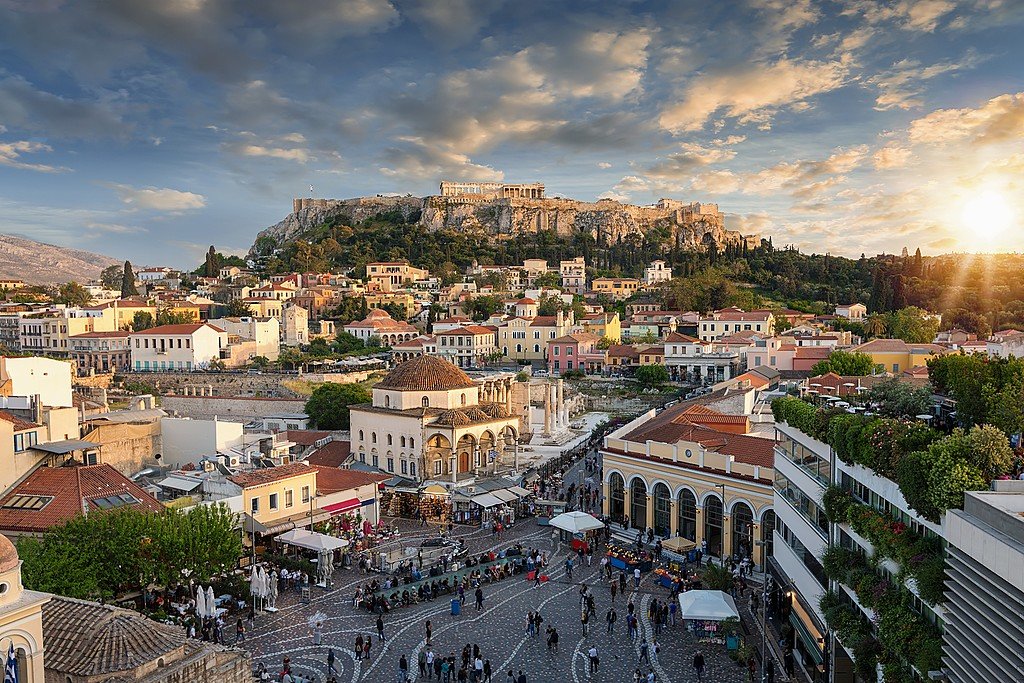
Time to say farewell to Greece. Enjoy your final Athenian breakfast before your transfer to the airport.


